Blog

Closer Look at Delinquency Surge and Much More -Mortgage Monitor
In its “first look” at Novemberrnmortgage data last week Black Knight Financial Services noted a significant surgernin mortgage delinquencies compared to the previous month. The 11.8 percent jump in mortgages that werern30 or more days past due brought the national delinquency rate to 6.08 percent,rnthe first time since February it had surpassed 6.0 percent, and was the largestrnmonth-over-month increase since 2008, a spike that also occurred in November.</p
In the newest edition of its Mortgage Monitor Black Knight takes arncloser look at the November anomaly, one that occurred even as the overallrndelinquency rate has continued to trend downward and despite the increase was 6rnpercent below its level a year earlier. Accordingrnto the Monitor, a sudden rise in therndelinquency rate in November is more rule than exception and, while this wasrnthe largest, increases have occurred in six of the last seven Novembers. </p
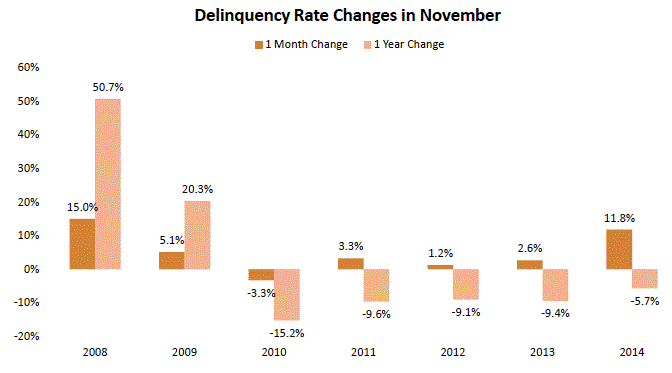 </p
</p
Black Knight said the November spike appearsrnto have been calendar driven. There wererntwo holidays (Veterans Day and Thanksgiving) during the month, as there alwaysrnare in November, with Thanksgiving typically knocking out the following day forrnmost people. This year the calendar placement of the holidays resulted in onlyrn18 possible payment processing days. The month ended on a Sunday as did the five recentrnNovembers with the largest increase in delinquencies. </p
November also saw the highest one monthrnvolume of loans rolling from current to 30-days delinquent since Junern2013. There were, in fact, increasedrnroll-rates across all early stage delinquencies while rolls from delinquent tornforeclosure status were still down.</p
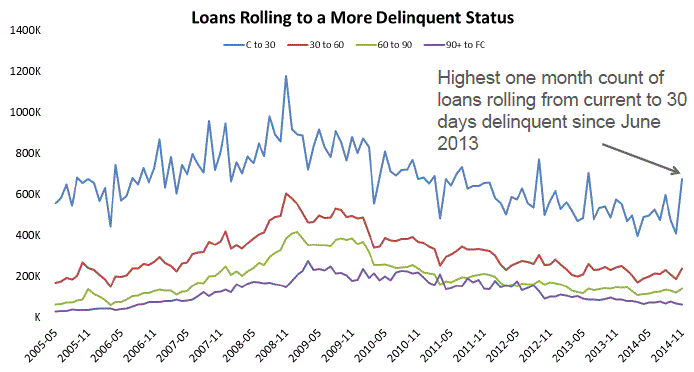 </p
</p
The month also saw the lowest cure volume</bof any month in the last 10 years and the third lowest in the past 15rnyears. Black Knight aid the decreased raternof loans returning from delinquency to current status might be partiallyrnaccounted for by the truncated payment processing period during the month.</p
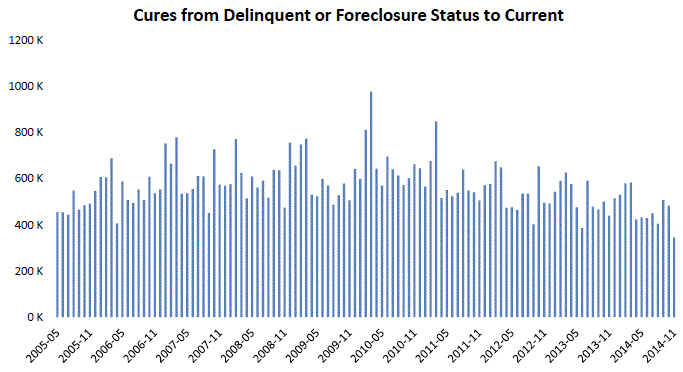 </p
</p
This issue of the Monitor also contains an evaluation of the differences in thernrecovery of home prices by property price tier. rnUsing its Home Price Index (HPI) the company put homes into five equalrnprice tiers for every zip code it tracks. rnTier 1 represents houses in the lowest 20 percent price range and Tier 5rnis the top 20 percent by price.</p
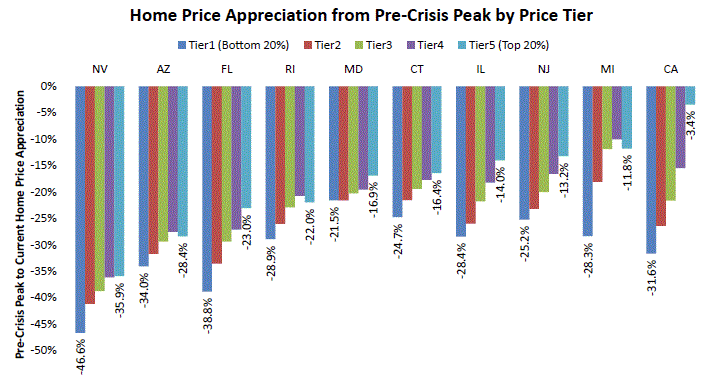 </p
</p
According to Trey Barnes, BlackrnKnight’s senior vice president of Loan Data Products, “We looked at HPIrnappreciation from pre-crisis peaks to today in the 10 states currently trailingrnthe furthest behind their pre-crisis housing maximums. The data showed a clearrndifference in the levels of recovery among home price tiers. Those in thernlowest 20 percent of home values have been lagging behind their higher-valuedrncounterparts in recovery to pre-crisis peaks, sometimes considerably. </p
“For example, in Nevada – overall,rnstill more than 39 percent off its pre-crisis peak – properties in the lowestrntier are nearly 47 percent off their peaks, as compared to 36 percent for thosernin the highest tier. In California, an even starker contrast emerges:rnproperties in the highest tier have now come within just over 3 percent ofrntheir pre-crisis peak, while those in the lowest 20 percent are still almost 32rnpercent down. In many cases, these disparities between price tiers can bernattributed to the fact that during the bubble, lower-tier propertiesrnappreciated at much higher rates than higher-valued properties and likewisernfell harder and further when the bubble broke.”</p
Finally, Black Knight looked at recentrnloan modification activity, noting that it had declined overall in 2014 and wasrndown from its high periods during the year as well. The Home Affordable Modification Programrn(HAMP), jointly sponsored by the Departments of Housing and Urban Development andrnTreasury, was dwarfed by private lenders in the numbers of modifications itrnprocessed in the 2009-2011 period, but was responsible for over 50 percent ofrnthe total by November of 2014. </p
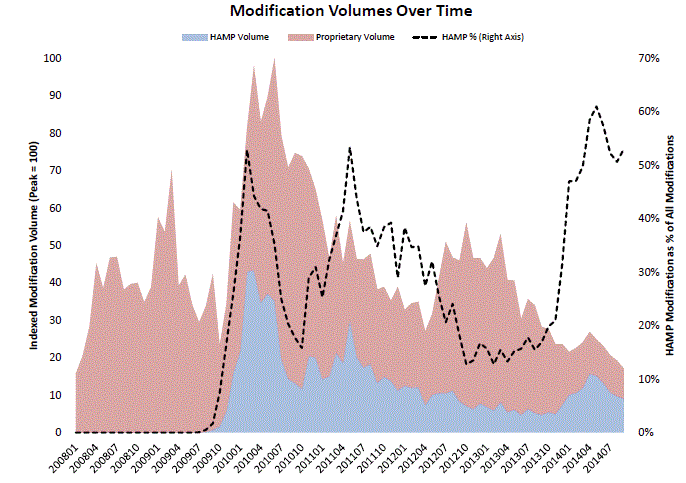 </p
</p
In addition to relative volume, therncomposition of investor types for which modifications were performed either byrnHAMP or through proprietary programs has shifted over the years as well. Loans owned or guaranteed by the governmentrnsponsored enterprises (GSEs) Freddie Mac and Fannie Mae were the source of over 70rnpercent of the modifications facilitated by HAMP in 2009 but are primarily thernprovince of proprietary programs today. The reverse has happened with VA and FHA loansrnwhich have gone from a negligible share of HAMP modifications in 2011 to overrn70 percent in 2014. </p
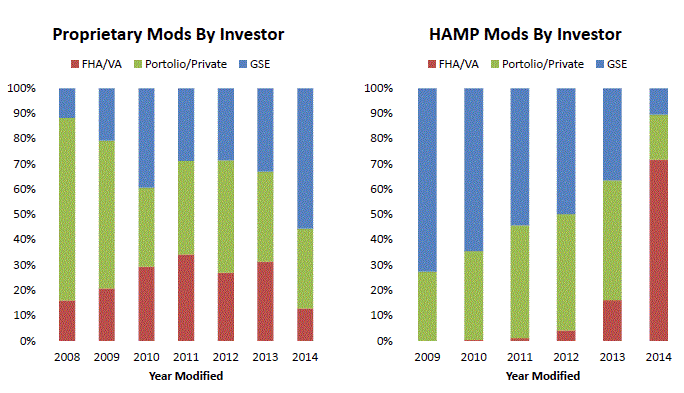 </p
</p
HAMP modifications have always featuredrnlarger monthly payment reductions than their proprietary counterparts. As HAMP’s client base has shifted toward thernsmaller VA/FHA loans these payment change amounts have decreased, butrnpercentage reductions among HAMP modifications are also down. </p
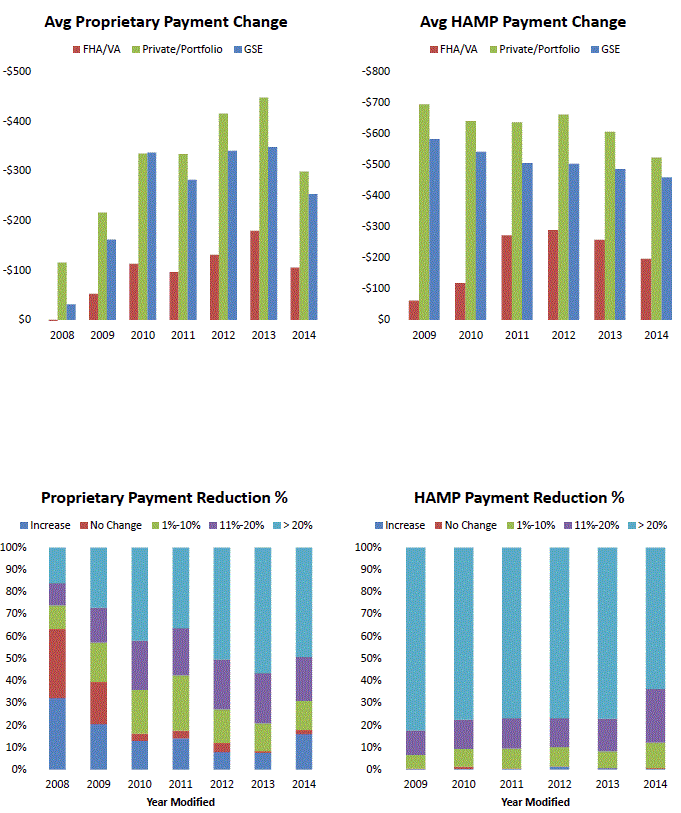 </p
</p
HAMP modifications have always performedrnbetter than their proprietary counterparts in terms of redefaults, That gap has narrowed but still persisted inrnrecent years, even as HAMP’s mix has moved overwhelmingly toward the higherrndefaulting FHA/VA loans. However BlackrnKnight notes that early data on 2014 HAMP modifications showed that vintage defaultingrnat a higher rate than modifications done in 2012 and 2013. </p
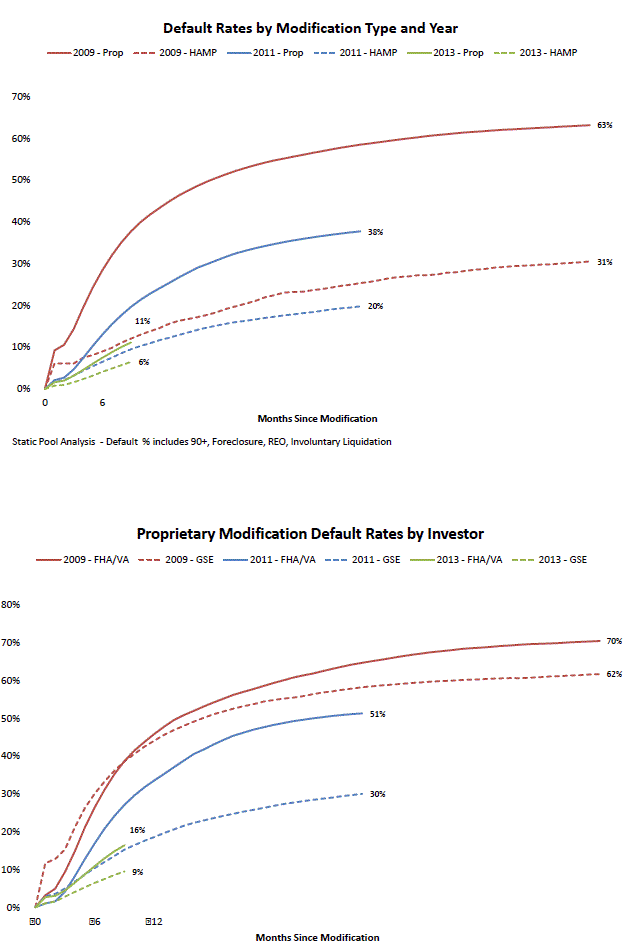 </p
</p
Step increases of interest rates onrnHAMP modifications began in the third quarter of 2014 although few loans havernyet been affected. Black Knight said thernimpact of the payment hikes will be more apparent beginning with the firstrnquarter of 2015 as the larger volumes of modifications done in 2010 hit theirrnfifth year, the benchmark for many interest rate increases.
All Content Copyright © 2003 – 2009 Brown House Media, Inc. All Rights Reserved.nReproduction in any form without permission of MortgageNewsDaily.com is prohibited.
Latest Articles
By John Gittelsohn August 24, 2020, 4:00 AM PDT Some of the largest real estate investors are walking away from Read More...
Late-Stage Delinquencies are SurgingAug 21 2020, 11:59AM Like the report from Black Knight earlier today, the second quarter National Delinquency Survey from the Read More...
Published by the Federal Reserve Bank of San FranciscoIt was recently published by the Federal Reserve Bank of San Francisco, which is about as official as you can Read More...

Comments
Leave a Comment